People
How Master Portraitist Jess T. Dugan Empowers Subjects to Open Up for Remarkably Intimate Photographs
Dugan belongs to a new generation of queer photographers focused on empowering their subjects.
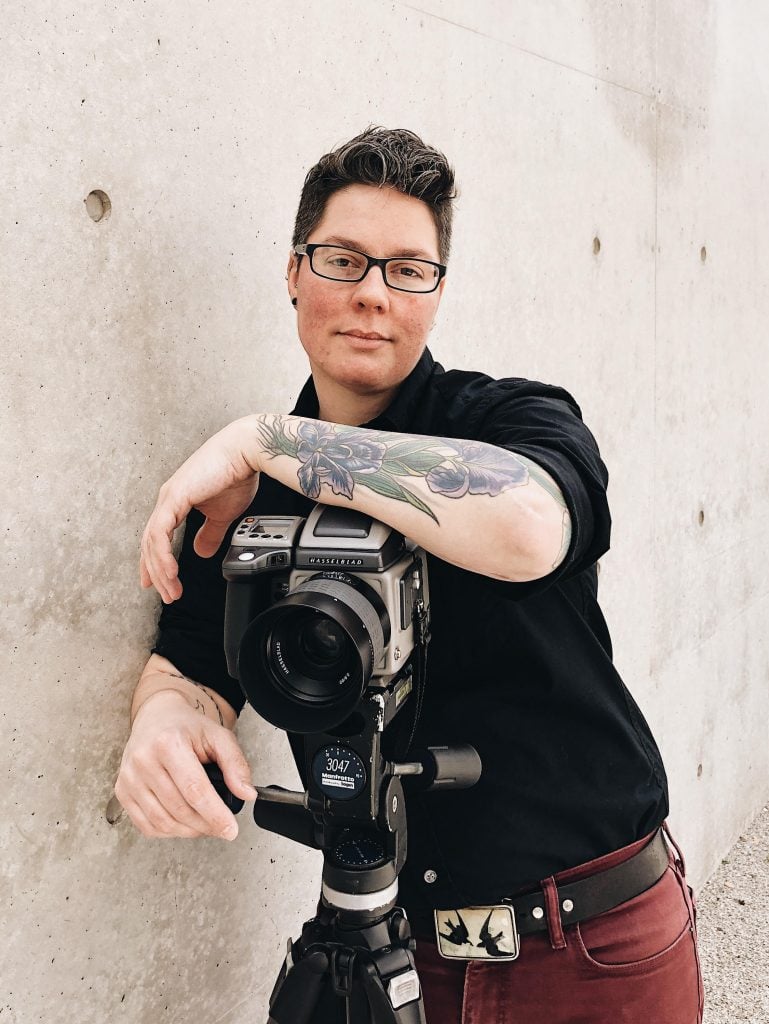
Dugan belongs to a new generation of queer photographers focused on empowering their subjects.

Taylor Dafoe

Jess T. Dugan’s portraits aren’t flashy. This is literally true—the artist only uses natural light for their tender photographs of friends, family, and members of the queer community. But it’s also true metaphorically, in that Dugan cuts their portraits down to the bare essentials, forgoing props, sets, and other frills for the sake of foregrounding their subject’s humanity.
And though there are manifold nods to art history, especially to Renaissance portraiture and works by contemporary queer artists like Catherine Opie and Del LaGrace Volcano, the referentiality stays in the background. A scholar and a layperson could look at a Dugan portrait and come away with the same experience: one of profound intimacy, of seeing someone being seen.
Dugan belongs to a new generation of queer photographers turning a lens on the underrepresented and hard to define—and breathing life into the often heteronormative, often objectifying genre of portraiture.
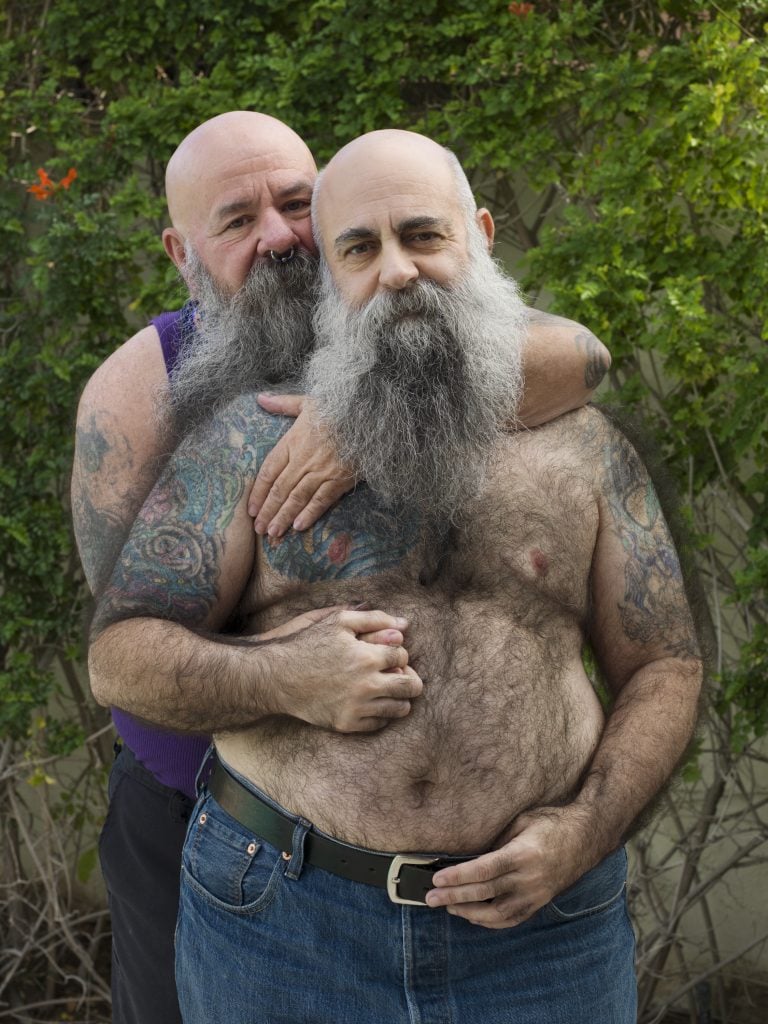
Jess T. Dugan, Sky, 64, and Mike, 55, Palm Springs, CA (2017). Courtesy of the artist and the Minneapolis Institute of Art.
The artist’s process is as stripped down as the pictures that emerge from it. Dugan’s equipment list rarely goes beyond a camera and a tripod; they almost always work without an assistant.
“I think there’s something important about showing up alone,” Dugan told Artnet News over the phone in early November. “I just find that there’s something about working that slowly and intentionally that allows the person I’m photographing to be really present and to engage in this collaboration with me. It leads to pictures that I feel are more emotionally and psychologically resonant.”
It was the afternoon after the election, still days before the results came into focus, but Dugan exuded calmness and comfort. A selection of photographs and interviews from To Survive on This Shore, a body of work by the artist and their partner, social worker Vanessa Fabbre, that looks at the lives of older transgender and gender-nonconforming people, just went up at the Minneapolis Institute of Art (MIA).
“There’s a beauty and a lifelike presence to the work that I think comes from Jess’s careful interactions and collaborations with their subjects,” says Casey Riley, curator and head of the department of photography and new media at MIA.
“It crystalizes this moment of encounter,” Riley continues. “I feel, when I’m standing in front of Jess’s work, that I am seeing the real person, unadulterated, in their vulnerability.”
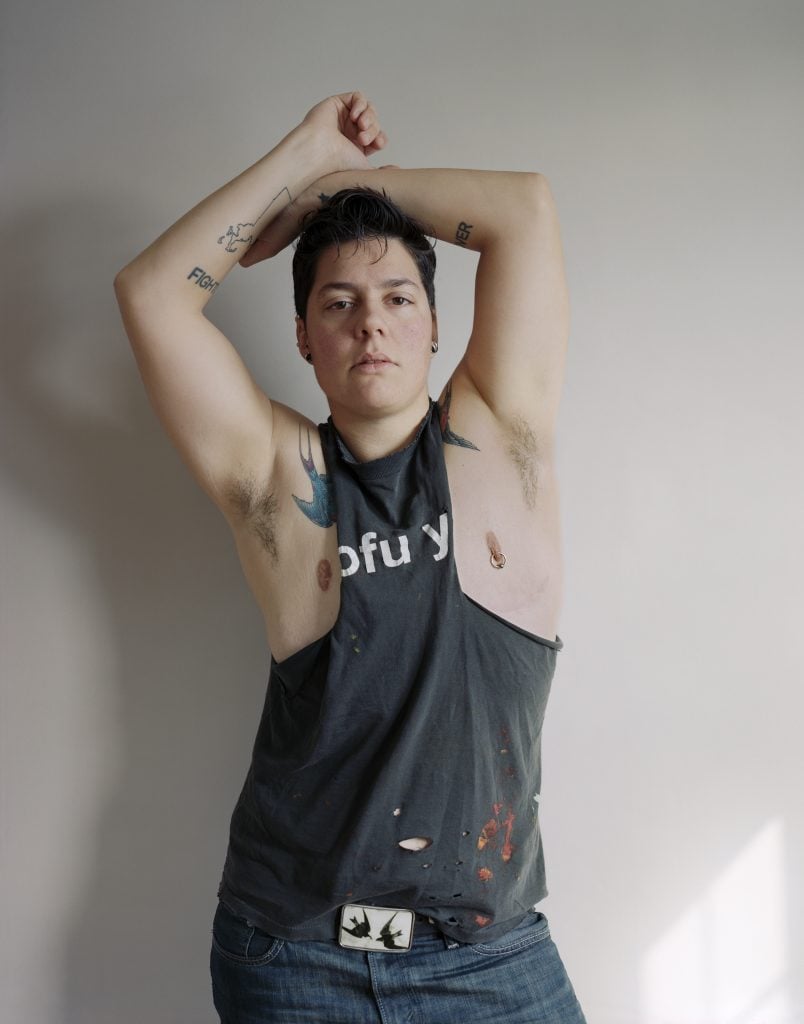
Jess T. Dugan, Self-portrait (muscle shirt) (2013). Courtesy of the artist and the Catherine Edelman Gallery, Chicago.
Each interview conducted for To Survive on This Shore, which was conceived as a book and published in 2018 by Kehrer Verlag, began with the same two questions: “How do you identify today? What are some key moments that led you to that identity?”
It’s a broad entree into someone’s life, but the way one answers it says a lot. My early November conversation with Dugan began with versions of these questions too.
The photographer, now 34, identifies as queer and non-binary. The rhetoric has evolved in recent memory, though the feeling behind it hasn’t. “My identity has been the same for a long time, but the language seems to change every two years,” they joke.
Dugan grew up in Little Rock, Arkansas. At 13, they moved with their mother to Cambridge, Massachusetts, where Dugan came out. “From a very early age,” the artist recalls, “I had a heightened awareness of my own gender and the way that I didn’t easily fit into the world.”
Though they had long carried around a camera, it wasn’t until late in high school that the artist embraced photography as an art form, and the lens as an instrument for activism. Their pictures then weren’t all that different from what they are now: portraits of people in the broader LGBTQ community, this time in the Boston area. Later, they went to the Massachusetts College of Art and Design and earned an MFA at Columbia College Chicago, where they studied under Dawoud Bey.
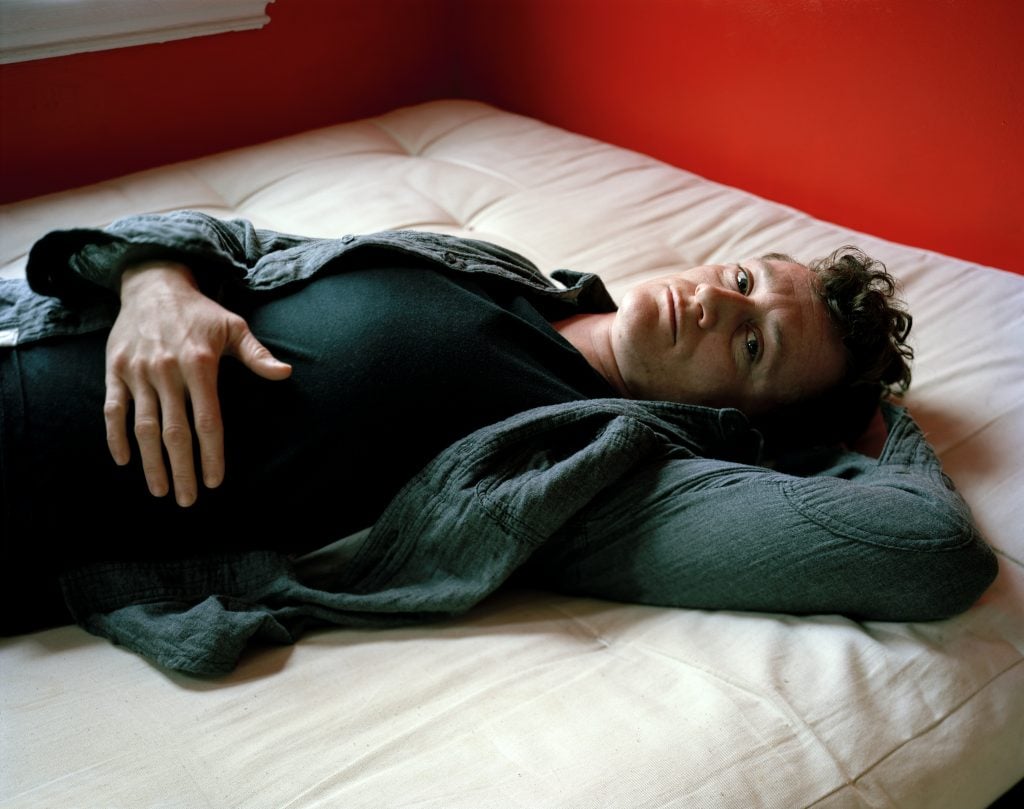
Jess T. Dugan, Dallas lying on the bed (2012). Courtesy of the artist and the Catherine Edelman Gallery, Chicago.
Around that time, Dugan began what would become Every Breath We Drew, a collection of portraits (including several self-portraits) loosely grouped around ideas of identity and desire that ushered in the artist’s pensive, stripped-back style to a wider audience.
“Rather than attempting to describe a specific identity or group—the gender identity and sexual orientation of the individuals varies—[the series] asks larger questions about how identity is formed, desire is expressed, and intimate connection is sought,” the artist wrote in a statement about the series. (A selection of shots from the collection were turned into a 2015 book, but the artist still considers the project ongoing.)
If Dugan has a signature gesture, it’s that their subjects almost always look directly at the camera lens. It’s a device deployed deftly throughout the portraits of Every Breath We Drew. In Dallas lying on the bed (2012), for instance, the titular figure reclines in an odalisque pose on a futon in a strawberry-red room, gaze perpendicular to the viewer. In Betsy (2013), the subject leans on a counter in a nondescript kitchen, their eyes the same shade of brown found on their button-up shirt. It’s hard not to look directly back.
The artist does this, they explain, to “give some of the power back to the subject and allow them to present themselves in a way that they want to be seen.”
But there’s another reason too. “It activates the experience for the viewer,” Dugan said. “The direct eye contact requires that they engage in this very human way. Part of what I hope happens is that when viewers look at my work, they’re not just looking at that particular person but also examining their own identity and their own assumptions that they’re bringing to this interaction.”
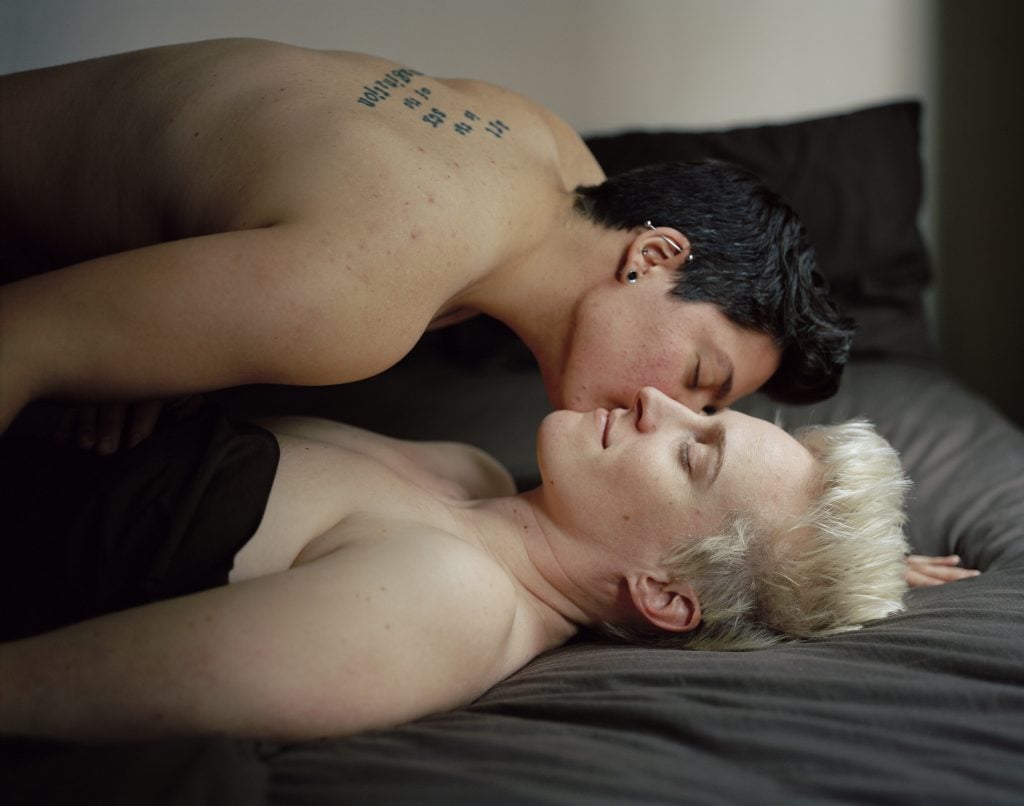
Jess T. Dugan, Jess and Vanessa (2013). Courtesy of the artist and the Catherine Edelman Gallery, Chicago.
Dugan moved with their partner, Fabbre, to St. Louis, Missouri, in 2014. (The couple still lives there today.) The year before that they began To Survive on This Shore. “Representations of older transgender people are nearly absent from our culture,” the duo notes in the introduction to the book, “and those that do exist are often one-dimensional.”
What follows is a series of nuanced portraits and interviews with a range of subjects.
Speaking of Hank and Samm, two Arkansas-based lovers—one 76 and wearing a US Army varsity jacket and hat; the other 67 and wearing a similar outfit with the logo of an NFL team—depicted in one photo, Riley, the MIA curator, notes the tenderness of the picture.
“They’re seated at a picnic table together, obviously affectionate,” Riley says. “They have that look about them that a couple of many years tend to have—they almost look the same in some ways, they have the same expressions. But on each of their faces, there’s an openness and a warmth‚ almost like they’re about to smile.”
“That immediacy,” Riley adds, “is something I always experience with Jess’s work.”
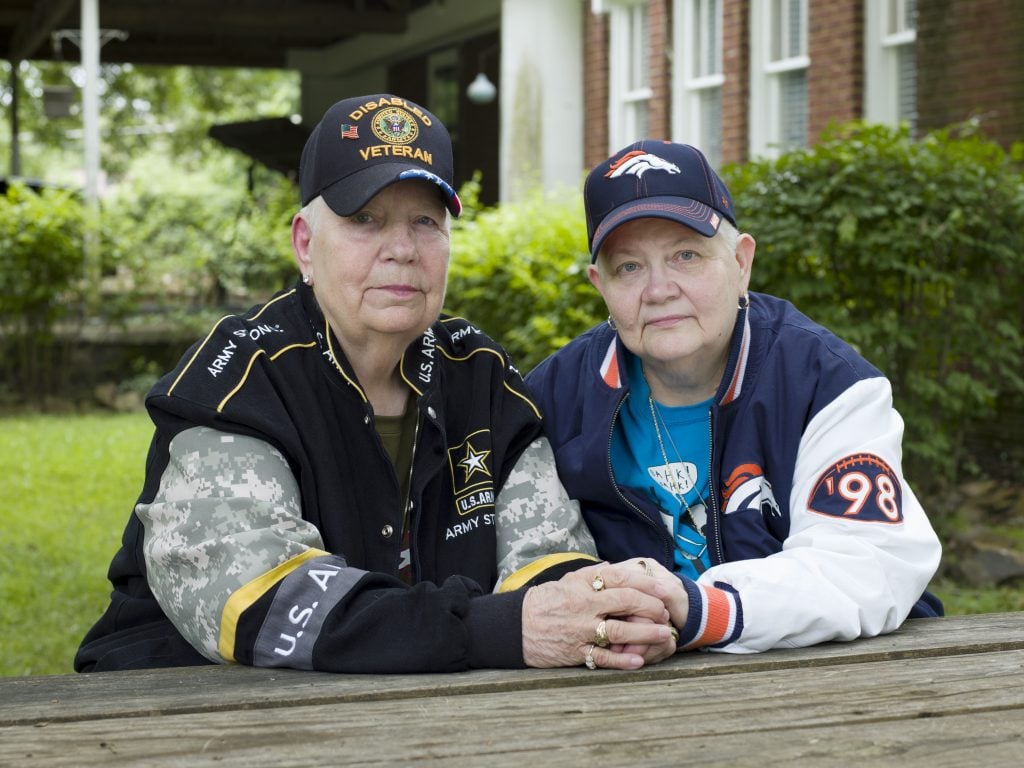
Jess T. Dugan, Hank, 76, and Samm, 67, North Little Rock, AR (2015). Courtesy of the artist and the Minneapolis Institute of Art.
The subjects of To Survive on This Shore were also asked a capstone question at the end of each interview, and so it seemed an appropriate way to close out my conversation with Dugan: “As you look ahead to getting older, what are some of your hopes and fears?”
“It’s funny, as you were saying that I realized I’ve never answered my own question,” they say with a laugh chased by a pregnant pause.
“Thinking about growing older, professionally, I just want to keep making my work. I feel there’s just so much more I want to do and say and I’m happy with what I’ve done, but like every other artist, I’m excited about what’s next. I want to keep using my work as a way to connect with other people. Because that’s the part of it I feel the most fulfilled by, both in terms of connecting with people that I’m photographing, but also the way that it allows me to connect with people who see the work—the viewers, the people who might find it meaningful.”